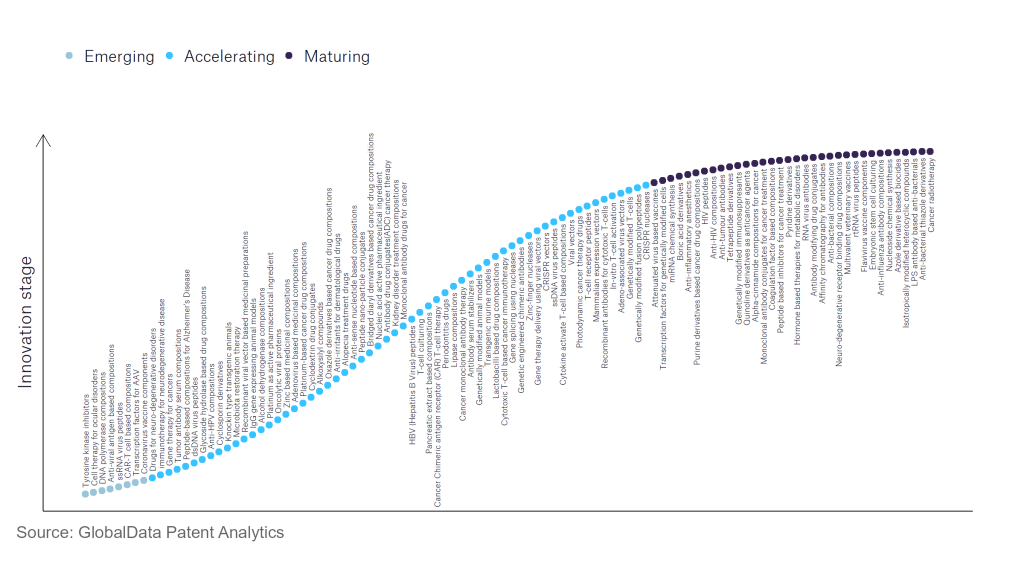English 

Rm 1955,Building 2,No.215,Lianhe North Rd.,Fengxian Dist.Shanghai 201417 China

Views: 0 Author: Premium Insights Publish Time: 2023-06-01 Origin: Site
The pharmaceutical industry continues to be a hotbed of innovation, with activity driven by the evolution of new treatment paradigms, and the gravity of unmet needs, as well as the growing importance of technologies such as pharmacogenomics, digital therapeutics, and artificial intelligence. In the last three years alone, there have been over 633,000 patents filed and granted in the pharmaceutical industry, according to GlobalData’s report on Innovation in Pharmaceuticals: Cyclodextrin drug conjugates.Leading innovators in cyclodextrin drug conjugates
However, not all innovations are equal and nor do they follow a constant upward trend. Instead, their evolution takes the form of an S-shaped curve that reflects their typical lifecycle from early emergence to accelerating adoption, before finally stabilising and reaching maturity.
Identifying where a particular innovation is on this journey, especially those that are in the emerging and accelerating stages, is essential for understanding their current level of adoption and the likely future trajectory and impact they will have.
110 innovations will shape the pharmaceutical industry
According to GlobalData’s Technology Foresights, which plots the S-curve for the pharmaceutical industry using innovation intensity models built on over 756,000 patents, there are 110 innovation areas that will shape the future of the industry.
Within the emerging innovation stage, cell therapy for ocular disorders, coronavirus vaccine components, and DNA polymerase compositions are disruptive technologies that are in the early stages of application and should be tracked closely. Adeno-associated virus vectors, alcohol dehydrogenase compositions, and antibody serum stabilisers are some of the
accelerating innovation areas, where adoption has been steadily increasing. Among maturing innovation areas are anti-influenza antibody compositions and anti-interleukin-1, which are now well established in the industry.
Innovation S-curve for the pharmaceutical industry

Cyclodextrin drug conjugates is a key innovation area in the pharmaceutical industry
Cyclodextrins (CDs) are polysaccharides formed by biodegrading starch using glucanotransferase enzyme. They are obtained in three different forms – alpha-CD, beta-CD, and gamma-CD. CDs are used where an encapsulation application is required for a pharmaceutical agent as they can host active molecules through their internal hydrophobic cavities. CDs also help in masking and prolonging the half-life of drugs used in the treatment of cancer.
GlobalData’s analysis also uncovers the companies at the forefront of each innovation area and assesses the potential reach and impact of their patenting activity across different applications and geographies. According to GlobalData, there are 50+ companies, spanning technology vendors, established pharmaceutical companies, and up-and-coming start-ups engaged in the development and application of cyclodextrin drug conjugates.
‘Application diversity’ measures the number of different applications identified for each relevant patent and broadly splits companies into either ‘niche’ or ‘diversified’ innovators.
‘Geographic reach’ refers to the number of different countries each relevant patent is registered in and reflects the breadth of geographic application intended, ranging from ‘global’ to ‘local’.
Axsome Therapeutics is the leading patent filer in cyclodextrin drug conjugates. Axsome Therapeutics is a biopharmaceutical company that develops and commercialises therapies for the treatment of central nervous system (CNS) disorders. Axsome is headquartered in New York, US.
In terms of application diversity, Takeda Pharmaceutical is the top company, followed by Bristol-Myers Squibb and Zhejian
g Jiuzhou Pharmaceutical. By means of geographic reach, Melinta Therapeutics holds the top position. While Foresee Pharmaceuticals and Sage Therapeutics stand in second and third positions, respectively.To further understand the key themes and technologies disrupting the pharmaceutical industry, access GlobalData’s latest thematic research report on Pharmaceutical.
